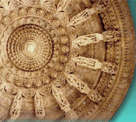 |
ஜீவபந்து T.S.ஸ்ரீபால்
Preface
The Book "Jinar Malaigal Alladhu Aravor Palligal" is of great
historical significance. It is a work of deep research and
embodies in it details of the severe austerities practised by Jain
saints in Tamil Nadu from time immemorial, of the great
contribution made by them to the enrichment of Tamil grammer and
literature and of the religious and educational centres
established by them to faster right conduct and knowledge among
the people.
The hills and caves where they lived and undertook penance in
Tamil Nadu for more than 2000 years are replete with historical
evidence in the form of carvings, sculptures of the Thirthankaras,
saintsbeds, and stone inscriptions.
Jeevabandhu Sri. T.S. Sripal has a first hand knowledge of almost
all these places of importance and so can speak of them with
authority and understanding. In a series of articles in "Nallaram",
a Tamil journal, he began describing them for the benefit of its
readers from 1969.
Lord Mahaveera's 25th Nirvana centenary commemoration volume
committee under the auspices of Sri Mahaveer Jain Kalyam Sangh of
Vepery. Madras-7 expressed desire that the articles should be
published in a book form so that they can have wider publicity.
Sri Sripal readily agreed to our proposal and the book was
released by His Holiness 1008 Sri Lakshmisena Bhattaraka
Bhattacharyavarya Swamiji, the Mathathipathi of Mel Sithamur on
13-11-74 the Deepavali Day at the Inaugural Function of Bhagavan
Mahaveer 2500th Pari Nirvana Mahotsava held at the premises of
Guru Shree Shanti Vijai Jain Vidyalaya 25-A, Vepery High Road,
Madras-7, under the auspices of Commemoration Volume Committee.
Sri T.S.Sripal is a powerful personality in Tamil Nadu. His
ceaseless efforts towards the elimination of animal sacrifice in
temples and his final success in inducting the Tamil Nadu
Government to ban the obnovious custom by law are so well-known
that they do not require any special mention. As long back as 1943
in a meeting organised to celebrate Mahaveer Jayanthi, he was
conferred with the title of "Jeevabandhu" by R.K. Shanmugam
Chettiar. Sri Sripal has also earned the title of "Jaina Samaya
Kaavalar" (the guardian of Jainism) from his affectivate admirers,
on account of the unique service rendered by him to the Jain
Society in Tamil Nadu for more than half a century.
This year, Jeevabandhu Sripal was honoured by the Veera Nirvana
Bharathi Sangh of Meerut the title of "Samaja Ratna" in a meeting
held at Delhi on 29-10-74 under the auspices of All India Digambar
Jain Sangh. The Vice-President of India, Sri B.D. Jatti, presided
over the meeting and presented him with the award which included a
gold medal, a cash of Rs. 2500/- and a golden shawl.
Another award also awaits Jeevabandhu Sripal. The Animal Welfare
Board of India has chosen him as a recipient of the title of "Prani
Mithra". The award is to be given in December 1974 by the
Rashtrapathi at NewDelhi.
We have every hope that the life of Jeevabandhu Sripal will shine
as a beacon light to generations to come and the honour and titles
earned by him will induce many youngsters to follow his footpath
in the service of humanity.
In a congratulatory lettar written on him by Sri Sahu Shanti
Prasad Jain, the President of the All India Digambar Jain Sangh,
he praised him as "You were rightly honoured for your great
services to the Community and religion".
We are indeed proud that we have been given the opportunity to
publish this rare book of historical importance by Jeevabandhu
Sri. T.S. Sripal. We have every hope that the book will be very
well received by the reading public to their benefit.
Madras-7
13-11-1974
Secretary,
The Commemoration Volume Committee.
ஜினர் மலைகள் அல்லது அறவோர் பள்ளிகள்
நாட்டின் மன்னன் செங்கோலனாயிருந்தால்தான் அவன் நாட்டில் சான்றோர் பலர்
இருப்பர். சான்றோராகிய அறவோர்கள் வாழ்ந்தால்தான் கலைகள் வளரும்.
மக்களுக்கு இன்றியமையாத ஒழுக்கமும், அறிவும் சிறப்புற்றிருக்கும்.
அறவோர் உள்ள நாட்டில் வானம் காலம் தவறாது பொழியும். நிலமும் வளம்
பெற்றுத் திகழும், பசியும் பிணியும் மக்களை வருத்தாது. இந்நிலை
முற்காலத்தில் பாரத நாடெங்கும் விளங்கிற்று. அக்கால மன்னர்கள் பலரும்
செங்கோலர்களாய்கத் திகழ்ந்தனர். அறவோர்களையும், சான்றோர்களையும்,
புலவர்களையும், கலைஞர்களையும் ஆதா�த்து வந்தனர். மக்களும் அறிவாலும்
ஒழுக்கத்தாலும் உயர்ந்திருந்தனர். வாழ்க்கை வளத்திலும்
மேன்மையுற்றிருந்தனர். மக்கள் நலத்தில் அக்கறைக் கொண்ட இம்மன்னர்களில்
பெரும்பாலோர் ஜைன மன்னர்களாய் விளங்கினர்.
இம்மன்னர்கள் பரத கண்டத்தை ஆண்ட காலத்தில் அந்நிய நாட்டார் எவரும் நம்
நாட்டின் மேல் படையெடுக்க இயலவில்லை. புருஷோத்தமன் காலத்தில்
படையெடுத்த அலெக்சாண்டரும் தோற்றோடி விட்டான். அது மட்டுமல்ல!
புருஷோத்தம மன்னா�ன் அருங்குணங்களையும் ஆற்றலையும் பாராட்டியதோடு
புருஷோத்தமரால் குறிப்பிட்ட நிர்வாணமாயுள்ள ஜைன முனிவர்பால்
அறங்கேட்டுப் பண்புடையவனாய் படையெடுக்கும் கொள்கையையே விட்டுவிட்டான்
என வரலாறு செப்புகிறது.
கி.மு. நூற்றாண்டுகளில் அரசாண்ட மன்னர்கள் பலரும் ஜைன சமயத்தைச்
சார்ந்தவர்கள் எனக் கூறினோம். இந்நிலை கி.பி. ஏழாம் நூற்றாண்டு வரைத்
தமிழகத்தில் நிலைத்து நின்றது. தமிழக மன்னர்களில் பெரும்பாலோர்
ஜைனர்களாயிருந்தும், புதிதாகத் தோன்றிய மற்ற மதங்களையும்
புறக்கணிக்காது ஆதா�த்தே வந்தனர். அம் மதங்களைச் சார்ந்திலராயினும்
மக்கள் நலத்தைப் பொ�தென மதித்தனர் அம்மன்னர்கள். இவ்வரலாற்றுண்மையை
ஆர்.ரைஸ் (R.Rys) என்ற மேல்நாட்டு அறிஞர் "பெளத்த இந்தியா" என்ற
நூலில் அஜாத சத்ரு என்ற ஜைன மன்னன், பெளத்த மதத்தையும் ஆதா�த்து
வந்தான் என்றும், அக்கால ஜைன மன்னர்கள் எல்லா மதத்தினருக்கும் ஆதரவு
அளித்து வந்தனர் என்றும், குறிப்பிட்டுள்ளார். இத்தகு மாண்புமிகு
மன்னர்கள் ஆட்சி செலுத்திய காலங்களில் நாட்டில் சான்றோர்கள்
நிறைந்திருந்தனர். இப்புண்ணிய மூர்த்திகள் காரணமாகவே நமது பாரத
நாட்டிற்குப் புண்ணிய பூமி எனப் பெயர் வழங்கலாயிற்று.
மெய்ப்பொருள் கண்ட மேதைகளும், மாசறு காட்சியோருமாகிய ஜைன முனிவர்கள்
பாரத நாடெங்கும் அறவுரைப் பகர்ந்து மக்கள் அறிவையும் பண்பாட்டையும்
வளர்த்து வந்தனர். இத்தூய அறவோர்கள் பாரத நாட்டின் பல
பாகங்களிலுமுள்ள மலைக் குகைகளில் தவமியற்றி அறம் வளர்த்து வந்தனர்.
குறிப்பாக நமது தமிழகத்திலும் கி.மு. நூற்றாண்டுகளிலிருந்து
கி.பி.10ஆம் நூற்றாண்டு வரை ஜைன முனிவர்கள் மலைக் குகைகளில் தவம்
புரிந்து கலைச் செல்வங்களையும் அறநெறிகளையும் வளர்த்து வந்த அரிய காட்சிகளை இன்றும் தமிழக மலைகள் பலவற்றில் காணலாம். இத்தூய
முனிபுங்கவர்களை அறவோர் என்றும் கடவுளர் என்றும் வணங்கி, அத்தவச்
செல்வர்கள் தவமியற்றிய மலைக் குகைகளை அறவோர் பள்ளிகள் என்றும்
அழைத்துப் போற்றி வந்தனர். அது மட்டுமல்ல. அப்புனித மலைகளைத் தெய்வீக
மலைகளாகப் போற்றி அன்பு மலைகள், அறநெறி மலைகள், அருள் மலைகள், அஹிம்ஸா
மலைகள், அறிவக மலைகள், கலைவளர் மலைகள், தத்துவ மலைகள், ஓலைச் சுவடிகள்
காட்சியளிக்கும் உயர் மலைகள் எனக் கொண்டாடிப் போற்றினர்.
இத்தகு மாண்பமைந்த மலைக்குகைகளில் வீற்றிருந்த ஐம்புலன்வென்ற
அறவோர்களின் அறிவாற்றலையும், தவச் சிறப்பையும், ஒழுக்க நெறிகளையும்
போற்றி நமது சங்க நூல்களில் ஒன்றாகிய மதுரைக் காஞ்சியில்,
"வண்டு படப்பழுநிய தேன்ஆர் தோற்றத்துப்
பூவும் புகையும் சாவகர் பழிச்ச,
சென்ற காலமும், வரூஉம் அமயமும்,
இன்று இவண் தோன்றிய ஒழுக்கமொடுநன்கு உணர்ந்து
வானமும் நிலனும் தாம்முழுது உணரும்,
சான்ற கொள்கை, சாயாயாக்கை,
ஆன்று அடங்கு அறிஞர் செறிந்தனர், நோன்மார்,
கல் பொளிந்தன்ன இட்டு வாய்க் கரண்டைப்
பல்புரிச்சிமிலி நாற்றி நல்குவர
கயம் கண்டன்ன வயங்குடை நகரத்து
செம்பு இயன்றன்ன செஞ்சுவர் புனைந்து,
நோக்கு விசை தவிர்ப்ப மேக்கு உயர்ந்து, ஓங்கி
இறும்பூது சான்ற நறும் பூஞ்சேக்கைகயும்-
குன்று பல குழிஇப் பொலிவன தோன்ற:
அச்சமும் அவலமும் ஆர்வமும் நீக்கி,
செற்றமும் உவகையும் செய்யாது காத்து,
ஞெமன்கோல் அன்ன செம்மைத்து ஆகி,
சிறந்த கொள்கை அறம்கூறு அவையமும்"
எனப் புகழப் பெற்றுள்ளது.







